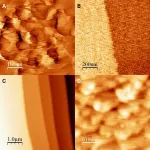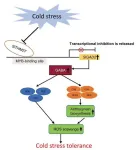(Press-News.org) MILL VALLEY, Calif. – July 9, 2024 – SynGAP Research Fund (SRF), a 501(c)(3) public charity whose mission is to improve the quality of life for patients suffering from SYNGAP1-Related Disorders (SRD) through the research and development of treatments, therapies, and support systems, has awarded a $130,000 grant to the University of Southern California’s Quadrato Lab to inspect and stratify the effects of specific SYNGAP1 variants on their patient-derived neuronal model system, furthering the world’s understanding of SynGAP function.
This grant builds on two previous SRF grants in 2020 and then 2021 to Dr. Marcelo Coba, a collaborator of Dr. Quadrato. Their collaboration is exactly the kind of research SRF is eager to support. For years, the Quadrato Lab has led the way in advancing the understanding of SynGAP function, in organoid models. They have discovered a previously unknown function of SynGAP in controlling human cortical neurogenesis. Results from this study – ‘Non-synaptic function of the autism spectrum disorder-associated gene SYNGAP1 in cortical neurogenesis’ – by Marcella Birtele and Ashley Del Dosso in the Quadrato lab was published late last year. USC’s article about this paper explains the importance of the findings.
In the next phase of their research, which will be supported by SRF, researchers in the Quadrato lab, including Dr. Marcela Birtele, will expand their work to inspect and stratify the effects of specific SYNGAP1 variants on their organoid model system. They will also examine the postsynaptic density (PSD) protein interaction network to better understand which other proteins interact with SynGAP in an important fashion and could present alternative targets for future therapeutics.
“This is a strong team of researchers that have been at the forefront of furthering our understanding of SynGAP,” said Michael Graglia, Managing Director of SRF. “With their work on complex models that few other labs have invested in, Drs. Birtele, Coba, and Quadrato have been very productive over the past few years, significantly expanding what we know about this critical neurological protein. I am thrilled SRF can support their progress and get us closer to a cure for SRD.”
About the Project
The goal of the two-year project is to help researchers and pharmaceutical companies better understand the effects of possible interventions and generate new ideas for treatments, specifically: Phenotypic characterization of SYNGAP1 pathogenic variants and CRISPRi screening of SynGAP protein interactors to unveil novel convergent signaling for the treatment of intellectual disability.
Dr. Giorgia Quadrato, PhD, assistant professor, stem cell biology and regenerative medicine and principal investigator, added: “We are so pleased to help SRF work towards the goal of finding a cure for SynGAP. With every new discovery, we are that much closer to the day when a diagnosis is not a lifelong sentence, but a moment in time that is followed by treatment and a lifetime of opportunities.”
About the Quadrato Lab
The Quadrato lab focuses on understanding the cellular and molecular basis of human brain development and neurodevelopmental disease. We seek to produce meaningful work that advances the fundamental knowledge of our field and provides new tools to do it. By combining emerging models of the human brain with single-cell omics approaches, we aim to identify cell type-specific disease mechanisms and, above all, new treatments for neurodevelopmental disorders. To improve the physiological relevance of human pluripotent stem cell-derived organoids, our lab is leveraging interdisciplinary strategies and technologies aimed at tighter regulatory control through bioengineering approaches, along with newer unbiased organoid analysis readouts.
About SYNGAP1-Related Disorder (SRD)
SYNGAP1-Related Disorder (ICD-10 F78.A1; ICD-11 LD90.Y) is a rare genetic disorder caused by variants on the SYNGAP1 gene that reduce SynGAP protein levels. SRF has identified 1,454 patients to date, the number is growing weekly. This protein acts as a regulator in the synapses (where neurons communicate with each other). When SynGAP protein levels are too low, we see an increase in excitability in the synapses making it difficult for neurons to communicate effectively. This leads to many neurological issues seen in SynGAP patients.
Symptoms of SYNGAP1 include primarily neurological issues, including autism spectrum disorder, intellectual disability, epilepsy, hypotonia (low muscle tone), gross and fine motor delays, and visual abnormalities such as strabismus (crossed eyes) as well as gastrointestinal challenges and disordered sleep.
About the SynGAP Research Fund (SRF)
The mission of the SynGAP Research Fund (SRF) is to improve the quality of life for SYNGAP1 patients through the research and development of treatments, therapies, and support systems.
SRF was founded in the US in 2018 as a 501(c)(3) US public charity, and families created sister organizations for SRF in the UK in 2020, in Europe (Netherlands) in 2022, and in Latin America (Colombia) in 2023.
Completely family-led, SRF is the largest non-government funder of SynGAP research having committed over $6 million in grants. The founders cover operational costs, ensuring donations fund science & patient-related programs. SRF’s grant program awards one or two-year grants to investigators, physician residents, and clinicians interested in studying SYNGAP1. SRF grants are intended to help researchers explore novel ideas and answer open questions related to the clinical aspects of and therapies for SRD.
For more on SRF, visit curesyngap1.org or follow @cureSYNGAP1 on LinkedIn, YouTube, Instagram, Facebook, TikTok, or X.
SRF is a member of FasterCures, COMBINEDbrain, Global Genes Foundation Alliance, Everylife Foundation Community Congress, Epilepsies Action Network, Personalized Medicine Coalition, Rare Epilepsy Network, Epilepsy Leadership Council, Alliance for Genetic Etiologies in Neurodevelopmental Disorders and Autism (AGENDA), California Action Link for Rare Diseases, American Brain Coalition, Genetic Alliance UK, Rare Disease UK, Syndromes Without a Name (SWAN UK), Jumpstart Program, Patient Worthy, Autism Brain Net, Innovation and Value Initiative, Rare Disease Diversity Coalition, Cambridge Rare Disease Network, Breaking Down Barriers, Rare-X, Mencap, IndoUSRare, and The World Orphan Drug Congress.
END
SynGAP Research Fund (SRF) increases support for SYNGAP1 organoid research at the University of Southern California’s Quadrato Lab
2024-07-09
ELSE PRESS RELEASES FROM THIS DATE:
Study finds 1 in 12 patients labeled as having ‘benign’ results actually had high-risk prostate cancer
2024-07-09
New research highlights the challenge of balancing the risks of overdiagnosing and underdiagnosing prostate cancer early enough to intervene and minimize risk of death. Recently, some experts have called for the lowest grade of prostate cancer—biopsy Gleason Grade Group (GGG) 1—to be reclassified as ‘benign.’ But a new study led by a researcher from Mass General Brigham has found that many patients with a biopsy GGG1 may have a more aggressive cancer than their biopsy alone suggests.
By looking at data from more than 10,000 patients at a university in Germany, researchers found that at least 8 percent of patients with this ...
Marcos Vilela wins Lilly Research Award for Doctoral Students
2024-07-09
The Royal Spanish Society of Chemistry (RSEQ) and Lilly have announced the winning theses of the 22nd Research Awards for Doctoral Students, which acknowledge outstanding work in the fields of Organic, Pharmaceutical, and Analytical Chemistry. Marcos Vilela, currently pursuing his PhD at the Center for Research in Biological Chemistry and Molecular Materials (CiQUS) at the University of Santiago de Compostela (USC), was awarded alongside Andrea Palone from the University of Girona (UdG) and the University of Rome "Tor Vergata," and Beatriz Arévalo from the Complutense University of Madrid (UCM).
Marcos' thesis, supervised by CiQUS Principal ...
Trust, more than knowledge, critical for acceptance of fully autonomous vehicles
2024-07-09
PULLMAN, Wash. – While not yet on the market, fully autonomous vehicles are promoted as a way to make road travel dramatically safer, but a recent study found that knowing more about them did not improve people’s perception of their risk. They needed to have more trust in them too.
This study adds to the evidence from other research that knowledge alone is not enough to sway people’s attitudes toward complex technology and science, such as gene editing or climate change. In this case, Washington State University researchers found that trust in the autonomous vehicles’ reliability and performance played the strongest role in improving ...
Run screaming or slow retreat? New study advances understanding of brain responses to emotionally-charged scenes
2024-07-09
The ability to recognise and respond to emotionally-charged situations is essential to a species’ evolutionary success. A new study published today [July 9th] in Nature Communications advances our understanding of how the brain responds to emotionally charged objects and scenes.
The research, led by Trinity College Dublin neuroscientist Prof. Sonia Bishop and Google researcher Samy Abdel-Ghaffar while he was a PhD student in Prof. Bishop's lab at UC Berkeley, has identified how the brain represents different categories of emotional stimuli in a way that allows for ...
Brain neurotransmitter receptor antagonist found to prevent opioid addiction in mice
2024-07-09
New research led by UCLA Health has found a drug that treats insomnia works to prevent the addictive effects of the morphine opioids in mice while still providing effective pain relief.
The study, published in the journal Nature Mental Health, concluded that suvorexant, which blocks brain receptors for a neurotransmitter called hypocretin, prevents opioid addiction. At high doses in humans, suvorexant induces sleep and is used to treat insomnia. But sleep was not induced, and behavioral alertness was maintained, at the much lower doses effective in preventing ...
Nerve damage from breast cancer treatment can be predicted
2024-07-09
Many women treated for breast cancer using taxanes, a type of cytostatic drug, often experience side effects in the nervous system. Researchers at Linköping University have developed a tool that can predict the risk level for each individual. The tool could help doctors adapt treatment to avoid persistent side effects in those at the greatest risk.
More and more people are becoming cancer survivors. But even if they have survived the disease, an increasing number still suffer from the side effects of cancer treatment. In a recent study from Linköping University, researchers studied the side effects of taxanes, ...
Water stored under artificial turf could make cities cooler and safer to play in
2024-07-09
For those living in cities, space to play sports outside can be a scarcity. Recently, natural grass in parks or public sports courts has often been replaced with more durable artificial turf to allow heavy consecutive use.
There are, however, downsides to this practice, both for people and for cities as a whole. Now, scientists in the Netherlands have set out to change that by integrating a subsurface water storage and capillary irrigation system under artificial turf sports fields.
“Here we show that including a subsurface water storage and capillary ...
How a plant app helps identify the consequences of climate change
2024-07-09
Plants are known to respond to seasonal changes by budding, leafing, and flowering. As climate change stands to shift these so-called phenological stages in the life cycle of plants, access to data about phenological changes – from many different locations and in different plants – can be used to draw conclusions about the actual effects of climate change. However, conducting such analyses require a large amount of data and data collection of this scale would be unthinkable without the help of citizen scientists. “The problem is that the quality of the data suffers when fewer people engage ...
Tomato triumph: genetic key to chill-proof crops unveiled
2024-07-09
In a significant advancement for agricultural biotechnology, researchers have identified a genetic mechanism that enhances the cold tolerance of tomatoes. This breakthrough is pivotal for cultivating crops in cooler climates, ensuring stable yields and bolstering global food security. The study focuses on the SlGAD2 gene, which, when overexpressed, elevates the plant's γ-aminobutyric acid (GABA) levels, boosts antioxidant activities, and stimulates anthocyanin production, collectively improving cold resilience.
Tomatoes play a vital role in global agriculture but are susceptible ...
Scientists exploring potential new treatments for glioblastoma
2024-07-09
A new approach to treating the most malignant type of brain cancer – glioblastoma – has shown strong promise in pre-clinical settings, raising hopes of increasing current average survival rates beyond 18 months.
Targeted alpha therapy (TAT) is emerging as a potential additional treatment for glioblastoma (GB), a disease which has confounded oncologists for decades due to its aggressive nature and strong resistance to existing therapies.
The current standard treatment for GB is surgery, followed by external beam radiotherapy and the chemotherapy drug, temozolomide. However, survival rates of less than 5-10% at five years have prompted researchers to explore ...







